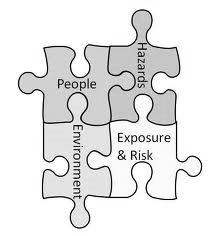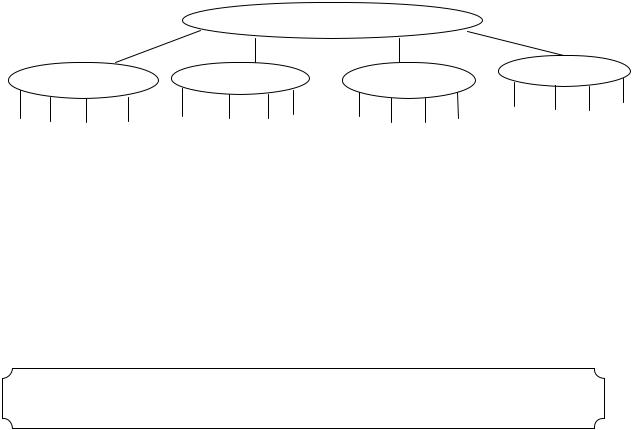
Англ. яз. для специалистов по защите окружающей среды и бж
.pdfОтравление, превентивные меры, профессиональные болезни, меры безопасности, вредные условия труда, опасное воздействие, воздействие токсинов, реализовывать элементы техники безопасности и охраны труда.
3.Read the text and match parts of the sentences in the table to reproduce the history of industrial hygiene.
In the fourth cen- |
Hippocrates |
|
described the diseases of miners and |
|
tury BC |
|
|
prescribed preventive measures. |
|
In the first cen- |
Pliny the Elder |
established the first state industrial |
||
tury AD |
|
|
hygiene programs. |
|
In the second |
Galen |
|
forced the British Parliament to pass |
|
century AD |
|
|
the Chimney-Sweepers Act. |
|
In 1556 |
Agricola |
|
asserted |
that occupational diseases |
|
|
|
should be studied in the work envi- |
|
|
|
|
ronment and not in hospital wards. |
|
In 1700 |
Bernardo Ramaz- |
noted lead toxicity in the mining in- |
||
|
zini |
|
dustry. |
|
In 1788 |
Percival Pott |
|
presented |
definitive proposals for |
|
|
|
eliminating unhealthful working con- |
|
|
|
|
ditions. |
|
In the early 20th |
Dr. Alice Hamil- |
described the pathology of lead poi- |
||
century |
ton |
|
soning. |
|
In 1913 |
the New |
York |
devised a face mask to protect work- |
|
|
Department |
of |
ers from exposure to dangerous gas- |
|
|
Labor and |
the |
es. |
|
|
Ohio Department |
|
|
|
|
of Health |
|
|
|
FROM THE HISTORY OF INDUSTRIAL HYGIENE
There has been an awareness of industrial hygiene since antiquity. The environment and its relation to worker health was recognized as early as the fourth century BC when Hippocrates noted lead toxicity in the mining industry. In the first century AD, Pliny the Elder, a Roman scholar, perceived health risks to those working with zinc and sulfur. He devised a face mask made from an animal bladder to protect workers from exposure to dangerous gases. In the second century AD, the Greek physician, Galen, accurately de-
scribed the pathology of lead poisoning and also recognized the hazardous exposures of copper miners to acid fumes.
In 1556, the German scholar, Agricola, advanced the science of industrial hygiene even further when, in his book De Re Metallica, he described the diseases of miners and prescribed preventive measures. The book included suggestions for mine ventilation and worker protection, discussed mining accidents, and described diseases associated with mining occupations such as silicosis.
Industrial hygiene gained further respectability in 1700 when Bernardo Ramazzini, known as the father of industrial medicine, published in Italy the first comprehensive book on industrial medicine, De Morbis Artificum Diatriba (The Diseases of Workmen). The book contained accurate descriptions of the occupational diseases of most of the workers of his time. Ramazzini greatly affected the future of industrial hygiene because he asserted that occupational diseases should be studied in the work environment rather than in hospital wards.
In England in the 18th century, Percival Pott and his findings on the insidious effects of soot on chimney sweepers forced the British Parliament to pass the Chimney-Sweepers Act of 1788. The passage of the English Factory Acts beginning in 1833 marked the first effective legislative acts in the field of industrial safety. The Acts, however, were intended to provide compensation for accidents rather than to control their causes. Later, various other European nations developed workers' compensation acts, which stimulated the adoption of increased factory safety precautions and the establishment of medical services within industrial plants.
In the early 20th century in the U.S., Dr. Alice Hamilton led efforts to improve industrial hygiene. She observed industrial conditions first hand and startled mine owners, factory managers, and state officials with evidence that there was a correlation between worker illness and exposure to toxins. She also presented definitive proposals for eliminating unhealthful working conditions. And in 1913, the New York Department of Labor and the Ohio Department of Health established the first state industrial hygiene programs.
Today, nearly every employer is required to implement the elements of an industrial hygiene and safety, occupational health, or hazard communication program and to be responsive to the Occupational Safety and Health Administration (OSHA) and its regulations.
4. Complete the summary to the article with proper words. (Consult Appendix 4). Write a similar summary in Russian.

The article presents a (brief / extended) (overview / research / analyses) of industrial hygiene development from antiquity till modern times. It gives valuable (information / figures /test results) about the earliest and further safety precautions implemented to increase workers safety and eliminate unhealthy working conditions.
5.Read the text “WORKSITE ANALYSES” and complete the list of tasks by providing the verbs with nouns used in the text.
Example: measure and identify exposures Reduce or remove _________________; isolate ____________________; eliminate ____________________; substitute ____________________; install ____________________;
inspect and maintain ________________; provide ____________________; schedule ____________________.
WORKSITE ANALYSIS
A worksite analysis is an essential first step that helps an industrial hygienist determine what jobs and work stations are the sources of potential problems. During the worksite analysis, the industrial hygienist measures and identifies exposures, problem tasks, and risks. The most-effective worksite analyses include all jobs, operations, and work activities. The industrial hygienist inspects, researches, or analyzes how the particular chemicals or physical hazards at that worksite affect worker health. If a situation hazardous to
health is discovered, the industrial hygienist recommends the appropriate corrective actions.
Industrial hygienists recognize that engineering, work practice, and administrative controls are the primary means of reducing employee exposure to occupational hazards.
Engineering controls minimize employee exposure by either reducing or removing the hazard at the source or isolating the worker from the hazard.
Engineering controls include eliminating toxic chemicals and substituting non-toxic chemicals, enclosing work processes or confining work operations, and the installation of general and local ventilation systems.
Work practice controls alter the manner in which a task is performed. Some fundamental and easily implemented work practice controls include (1) changing existing work practices to follow proper procedures that minimize exposures while operating production and control equipment; (2) inspecting and maintaining process and control equipment on a regular basis; (3) implementing good housekeeping procedures; (4) providing good supervision; and (5) mandating that eating, drinking, smoking, chewing tobacco or gum, and applying cosmetics in regulated areas be prohibited.
Administrative controls include controlling employees' exposure by scheduling production and tasks, or both, in ways that minimize exposure levels. For example, the employer might schedule operations with the highest exposure potential during periods when the fewest employees are present. When effective work practices or engineering controls are not feasible or while such controls are being instituted, appropriate personal protective equipment must be used. Examples of personal protective equipment are gloves, safety goggles, helmets, safety shoes, protective clothing, and respirators. To be effective, personal protective equipment must be individually selected, properly fitted and periodically refitted; conscientiously and properly worn; regularly maintained; and replaced, as necessary.
6. Make a plan of the article in the form of questions. The first is done for you.
1.What is the main task of worksite analyses?
2.…
7.Write a detailed summary of the article WORKSITE ANALYSIS. Consult Appendix 4.
8.You are going to read the text CHEMICAL HAZARDS. Before you read learn these terms.
contaminant |
загрязняющее вещество |
particle |
частица |
solid |
твердое тело |
liquid |
жидкость |
volatile |
летучий |
evaporation |
испарение |
solvent |
растворитель |
9.Read the text CHEMICAL HAZARDS and guess Russian equivalent for the terms:
vapor |
dust |
fume |
mist |
|
fiber |
CHEMICAL HAZARDS
These are commonly classified as either particulate or gas and vapor contaminants. The most common particulate contaminants include dusts, fumes, mists, aerosols, and fibers. Dusts are solid particles that are formed or generated from solid organic or inorganic materials by reducing their size through mechanical processes such as crushing, grinding, drilling, abrading or blasting.
Fumes are formed when material from a volatilized solid condenses in cool air. In most cases, the solid particles resulting from the condensation react with air to form an oxide.
Fibers are solid particles whose length is several times greater than their diameter.
The term mist is applied to a finely divided liquid suspended in the atmosphere. Mists are generated by liquids condensing from a vapor back to a liquid or by breaking up a liquid into a dispersed state such as by splashing, foaming or atomizing. Aerosols are also a form of a mist characterized by highly respirable, minute liquid particles.
Gases are formless fluids that expand to occupy the space or enclosure in which they are confined. Examples are welding gases such as acetylene, nitrogen, helium, and argon; and carbon monoxide generated from the operation of internal combustion engines or by its use as a reducing gas in a heat treating operation. Another example is hydrogen sulfide which is formed wherever there is decomposition of materials containing sulfur under reducing conditions.
Liquids change into vapors and mix with the surrounding atmosphere through evaporation. Vapors are the volatile form of substances that are normally in a solid or liquid state at room temperature and pressure. They are formed by evaporation from a liquid or solid and can be found where parts cleaning and painting takes place and where solvents are used.
Airborne chemical hazards exist as concentrations of mists, vapors, gases, fumes, or solids. Some are toxic through breathing and some of them irri-

tate the skin on contact; some can be toxic by absorption through the skin or through ingestion, and some are corrosive to living tissue.
The degree of worker risk from exposure to any given substance depends on the nature and potency of the toxic effects and the magnitude and duration of exposure.
10. Complete the classification and comment upon it. The phrase below will help you.
Air contaminants can be divided into two groups. They are… Particulate contaminants include…
Such factors as … form the group of…
Air Contaminants
particulate
dust |
welding gases |
11. Read about biological hazards and write out:
•biological hazards;
•occupations which are exposed to biological hazards;
•methods preventing biological hazards.
BIOLOGICAL HAZARDS
These include bacteria, viruses, fungi, and other living organisms that can cause acute and chronic infections by entering the body either directly or through breaks in the skin. Occupations that deal with plants or animals or their products or with food and food processing may expose workers to biological hazards. Laboratory and medical personnel also can be exposed to biological hazards. Any occupations that result in contact with bodily fluids pose a risk to workers from biological hazards.
In occupations where animals are involved, biological hazards are dealt with by preventing and controlling diseases in the animal population as well as proper care and handling of infected animals. Also, effective personal hygiene, particularly proper attention to minor cuts and scratches, especially those on the hands and forearms, helps keep worker risks to a minimum.

In occupations where there is potential exposure to biological hazards, workers should practice proper personal hygiene, particularly hand washing. Hospitals should provide proper ventilation, proper personal protective equipment such as gloves and respirators, adequate infectious waste disposal systems, and appropriate controls including isolation in instances of particularly contagious diseases such as tuberculosis.
12. Read about physical hazards and fill in the table.
Type of physical hazards |
Methods to provide workers’ safety |
|
|
|
|
PHYSICAL HAZARDS
These include excessive levels of ionizing and nonionizing electromagnetic radiation, noise, vibration, illumination, and temperature.
In occupations where there is exposure to ionizing radiation, time, distance, and shielding are important tools in ensuring worker safety. Danger from radiation increases with the amount of time one is exposed to it; hence, the shorter the time of exposure the smaller the radiation danger.
Distance also is a valuable tool in controlling exposure to both ionizing and non-ionizing radiation. Radiation levels from some sources can be estimated by comparing the squares of the distances between the worker and the source. For example, at a reference point of 10 feet from a source, the radiation is 1/100 of the intensity at 1 foot from the source.
Shielding also is a way to protect against radiation. The greater the protective mass between a radioactive source and the worker, the lower the radiation exposure.
Nonionizing radiation also is dealt with by shielding workers from the source. Sometimes limiting exposure times to nonionizing radiation or increasing the distance is not effective. Laser radiation, for example, cannot be controlled effectively by imposing time limits. An exposure can be hazardous that is faster than the blinking of an eye. Increasing the distance from a laser source may require miles before the energy level reaches a point where the exposure would not be harmful.
Noise, another significant physical hazard, can be controlled by various measures. Noise can be reduced by installing equipment and systems that have been engineered, designed, and built to operate quietly. Substituting quiet work methods for noisy ones is another significant way to reduce noise.
Also, treating floors, ceilings, and walls with acoustical material can reduce reflected or reverberant noise. In addition, erecting sound barriers at adjacent work stations around noisy operations will reduce worker exposure to noise generated at adjacent work stations.
It is also possible to reduce noise exposure by increasing the distance between the source and the receiver, by isolating workers in acoustical booths, limiting workers' exposure time to noise, and by providing hearing protection.
Another physical hazard, radiant heat exposure in factories such as steel mills, can be controlled by installing reflective shields and by providing protective clothing.
13. Read about ergonomic hazards and write out:
•types of ergonomic hazards;
•conditions which can cause ergonomic hazards;
•measures to avoid ergonomic hazards.
ERGONOMIC HAZARDS
The science of ergonomics studies and evaluates a full range of tasks including lifting, holding, pushing, walking, and reaching. Many ergonomic problems result from technological changes such as increased assembly line speeds, adding specialized tasks, and increased repetition; some problems arise from poorly designed job tasks. Any of those conditions can cause ergonomic hazards such as excessive vibration and noise, eye strain, repetitive motion, and heavy lifting problems. Improperly designed tools or work areas also can be ergonomic hazards. Repetitive motions or repeated shocks over prolonged periods of time as in jobs involving sorting, assembling, and data entry can often cause irritation and inflammation of hands and arms.
Ergonomic hazards are avoided primarily by the effective design of a job or jobsite and by better designed tools or equipment that meet workers' needs in terms of physical environment and job tasks. Through thorough worksite analyses, employers can set up procedures to correct or control ergonomic hazards by using the appropriate engineering controls (e.g., designing or redesigning work stations, lighting, tools, and equipment); teaching correct work practices (e.g., proper lifting methods); employing proper administrative controls (e.g., shifting workers among several different tasks, reducing production demand, and increasing rest breaks); and, if necessary, providing personal protective equipment. Evaluating working conditions

from an ergonomics standpoint involves looking at the total physiological and psychological demands of the job on the worker.
Overall, industrial hygienists point out that the benefits of a welldesigned, ergonomic work environment can include increased efficiency, fewer accidents, lower operating costs, and more effective use of personnel.
14. Do the crossword
Across:
1)organism that can cause infection by entering the body;
2)volatile solids or liquids;
3)solid organic or inorganic particles formed as a result of mechanical processing of some material;
4)state of being uncovered or left without protection;
5)a tool to protect from radiation, noise, heat;
6)something likely to cause damage or loss;
7)formless fluids that expand to occupy the space or enclosure in which they are confined;
8)liquid in a dispersed state;
9)a loud or disturbing sound;
10)a slight continuous shaky movement.
Down:
a piece of equipment protecting against biological and chemical hazards.
1
2
3
4
5
6
7
8
9
10

15. Make a classification of workplace hazards.
Workplace hazards
chemical hazards
bacteria
13. Comment upon the classification of workplace hazards (See Activity 7). Below there are more verbs to help you.
To be classified into…
To comprise…
To consist of…
To be called…
16. Write an abstract to the four texts (Activities 6,8,9,10). Consult Appendix 3.
In this unit you will be asked to do some experiments. Please, review SAFETY PRECAUTIONS before starting any experiment.
17.Five statements are NOT CORRECT. Find and correct them.
PREPARING
•Clear all surfaces before beginning experiments.
•Read the entire experiment before you start.
•Know the hazards of the experiments and anticipate dangers.
PROTECTING YOURSELF
•Follow the directions step by step.
•Perform several experiment at a time.
•Locate exits, fire blanket and extinguisher, master gas and electricity shut-offs, eyewash, and first-aid kit.
•Make sure there is adequate ventilation.
•Wear open-toed shoes.
•Keep floor and workspace neat, clean, and dry.
•Clean up spills immediately.
•Tie back long hair.
•Wear safety glasses or goggles, apron, and gloves
•Never eat, drink, or smoke in the laboratory or workspace.
USING EQUIPMENT WITH CARE
